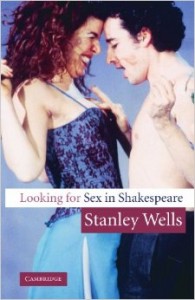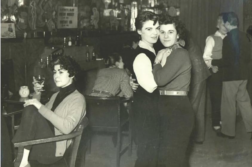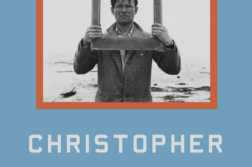 Looking for Sex in Shakespeare
Looking for Sex in Shakespeare
by Stanley Wells
Cambridge University Press
111 pages, $16. (paper)
DESPITE its slender size and breezily elegant prose, Looking for Sex in Shakespeare is a richly informative and learned book that endeavors to take a fresh look at a topic that’s been on everyone’s mind for at least the last century: the role and importance of sex in Shakespeare’s plays and poems. While the book is ostensibly about sex in general, it soon turns into a rumination on the homosexual and homoerotic content of the bard’s sonnets and plays (much to the delight of at least some readers, I trust).
Stanley Wells casts a skeptical eye both on the traditional denials and on recent boosterism of the “gay” content in Shakespeare’s works. Applying a rigorous standard to what’s admissible as such, he concludes in effect that the plays offer relatively sparse ground for same-sex interpretations, and those that do so are not terribly flattering (think Iago in Othello). The sonnets, on the other hand, are hard to dismiss as other than the expression of a man in love with a beautiful youth and probably in lust with him, as well. Let us focus on the sonnets.
First, Wells puts to rest some notions that have traditionally served as cover for the sonnets’ apparent homoerotic intent. The suggestion that it was common practice for men in Elizabethan England to write flowery poems to other men as an expression of manly friendship is simply false. No, sonnets were written by a man to his special lady friend as part of a courtship ritual that allowed him to impress her with his cleverness (or mere literacy) while flattering her to high heaven. That Shakespeare was writing to a man in the sonnets (or at least the first 126) is beyond doubt—he’s variously addressed as “Lord,” “sweet boy,” “lovely boy,” and so on—and it’s truly extraordinary. What’s more, it appears that Shakespeare wrote these poems for private circulation only, presumably to be delivered to the young man, which is to say he was following the epistolary convention of sonnet-writing throughout Europe at this time.
But there the poet’s fidelity to custom ends, as Shakespeare goes on to violate the most fundamental principle of the sonnet as it had come to be written after Petrarch set the standard in the 14th century. What the form required was that the poet conjure a woman of the most unimaginable perfection, exuding all the traits of the gods (or Christian virtues, depending on one’s taste), a remote image of Womanhood whose hand the poet had no right to hope for. The woman being addressed in the apostrophe was not the flesh-and-blood person who would receive the sonnet in the morning mail, still in curlers, much less a celebration of actual things she and the poet had done together in the real world. Shakespeare broke with this convention in every detail, addressing himself to a physically beautiful but morally flawed young man with whom he had shared specific experiences and conversations in the recent past, and whom he expected to see again next week. While it’s still possible, of course, that Shakespeare was making the whole narrative up, this concreteness raises the stakes for any interpretation that acknowledges the extreme intimacy of the sonnets, the amazing liberties the poet was willing to take in addressing this young man.
Since earlier Shakespeare had gone to considerable lengths to publish his longer poems, notably “Venus and Adonis,” it’s fair to conclude that he wasn’t writing the “gay” sonnets in response to convention but rather as a private and elaborate attempt at seduction. But whether we can infer an actual physical relationship between the two men is a question that Shakespeare is not about to settle easily. The sonnet that comes closest to providing a key is number 20, which leaves no doubt as to the gender of the recipient but allows for loads of ambiguity as to the nature of the men’s relationship.
A woman’s face with Nature’s own hand painted
Has thou, the master-mistress of my passion;
A woman’s gentle heart, but not acquainted
With shifting change, as is false women’s fashion;
An eye more bright than theirs, less false in rolling,
Gilding the object whereupon it gazeth;
A man in hue, all “hues” in his controlling,
Which steals men’s eyes and women’s souls amazeth.
And for a woman wert thou first created;
Till Nature, as she wrought thee, fell a-doting,
And by addition me of thee defeated,
By adding one thing to my purpose nothing.
But since she prick’d thee out for women’s pleasure,
Mine be thy love and thy love’s use their treasure.
Even a surface reading of this poem finds Shakespeare turning the man, his “master-mistress,” into a woman in his mind’s eye, in this way making it possible for him to consummate a redoubtable physical desire. Such a fantasy seems to acknowledge the impracticality of a physical entanglement—but also its conceivability—and the need to content oneself with a fantasy. Wells points out that Shakespeare breaks utterly with sonnet convention, not to mention Elizabethan decorum, when he refers directly to the other man’s genitals in the phrase “by adding one thing.” Yet these words are followed by “to my purpose nothing,” which has been taken as a forthright denial of a sexual connection. More recent scholars have found an ambiguity here—as well as in the following line, “But since she prick’d thee out for women’s pleasure,” whose final phrase could mean that his destiny is to give pleasure to women or that it’s to receive pleasure in the way that women do. Either way, the poet’s longing for this young man who “steals men’s eyes,” however legitimated by a change of gender, is almost palpable.
Skeptics of a homosexual reading also point out, not unreasonably, that the final 28 sonnets, which are addressed not to the young man but to a “dark lady,” are much more explicitly sexual than are the first 126, leaving little doubt as to the nature of this relationship. Of course, the poet would not be expected to address a man of noble birth in the same way that he would a low-born woman, possibly a harlot. So, if the latter poems are unusual for their sexual candor, the former are no less astonishing for the sheer brazenness with which Shakespeare praises his young friend, whose physical demeanor he admires in every detail. The question of whether the poet ever acted on his lust for the young man or kept it in check for the sake of social propriety is not answerable and perhaps not very important. (This not-acted-upon lust returns as the “fortune and men’s eyes” of another sonnet, which became the title of an early gay-themed movie in 1971.)
In the last of three chapters Wells explores the plays, which contain few certain references to same-sex sexual behavior but lots of contenders. While Wells is cautious not to over-interpret the ambiguous references—and lord knows Shakespeare was a master of the double entendre—he points out that many exchanges between two men, were they between characters of the opposite sex, would be assumed to be expressions of erotic love. Instead, these passages have generally been dismissed as expressions of male camaraderie à la 16th-century custom.
It is only in recent decades that scholars have begun to raise “the gay question” at all, and only a century, give or take—since perhaps the time of Freud—that they’ve discussed with honesty the myriad heterosexual references and subplots in Shakespeare. Wells’s main project is to show how past ages have dealt with this ever-vexing topic, offering examples of how sexual allusions have been variously ignored, suppressed, denied, and even at times exaggerated over the past 400 years. These variations tell us more about a given historical era or writer than about Shakespeare himself, whose ability to encase multiple meanings in just a few words will undoubtedly keep scholars guessing for generations to come.





